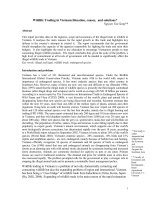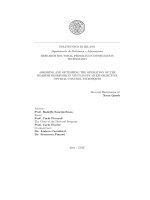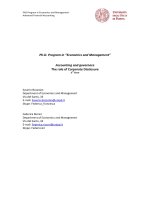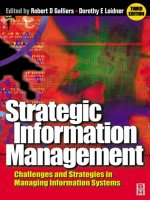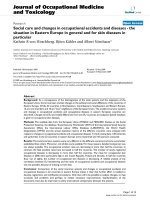Sustainable rice straw management in Vietnam: Current situation, challenges and potential
Bạn đang xem bản rút gọn của tài liệu. Xem và tải ngay bản đầy đủ của tài liệu tại đây (187.63 KB, 8 trang )
Journal of Vietnam Agricultural Science and Technology - No.1(3)/2018
bio-pesticides against thrips, rips tabaci infesting
cotton. International Journal of Plant Protection,
3 (1): 43-45.
Cermeli, 1993. Preliminary results on the chemical
control of
rips palmi Karny ( ysanoptera:
ripidae) on beans Phaseolus vulgaris. L. Bioletin
de Entomology venezalona.
Chin, L.W., 2016. Taxonomical discription of
Terebrantian thrips (Insecta:
ysanoptera) in
Taiwan. Available from: .
Dodia, D.N., Patel, I.S. and Patel, G.M., 2008. Botanical
pesticides for pest management. Scienti c publishers
(India): 276-282.
Fitriasari, E.D. and Prijono, D., 2009. E ectiveness
of two botanical insecticide formulation to two
major cabbage insect pests on eld application.
International Society for Southeast Asian Agricutural
Sciences, 15 (1): 42-51.
Ha Quang Hung, Yorn Try, and Ha
anh Huong,
2005. rips on plant crops and their management.
Agricultural Publishing, Ha Noi.
Hamid-Reza, P., 2009. Study on biology of onion rips,
rips tabaci Lindeman ( ysanoptera: ripidae)
on cucumber in laboratory conditions. Journal of
Plant Protection Research, 49: 390-394.
Henderson, C.F. and Tilton, E.W., 1955. Tests with
acaricides against the brown wheat mite. Journal
Economic Entomology, 48: 157-161.
Hoang Anh Tuan, 2002. e composition of thrips on
cotton in Nha Ho, Ninh
uan province. Master
Science
esis at Vietnam National University of
Agriculture-Vietnam.
Huynh anh Loc, Tran i My Hanh, and Nguyen
Van Hoa, 2016. Key for identi cation of thrips on
dragon fruit on dragon fruit. Science Annual Report
of Southern Horticultural Research Institute. Tien
Giang, December 2016.
Krantz, G.W., 1975. A manual of acarology. O.S.U.
Book Stores, Corvallis, Oregon: 335 p.
MARD, 2017. Report on the status of fruit production.
eme: Solution of sustainable development for
fruit crops in Southern provinces. @ Agricultural
extension forum. National Agricultural Extension
Center. Ministry of Agriculture and Rural
Development, Ben Tre, 16/2017: 31-40.
Martin, J.L. and Mau, R.F.L., 1992.
rips palmi
(Karny), crops knowledge master. Crop Protection,
26/8, 1089-1098.
Morse, J.G. and Hoddle, M.S., 2006. Invasion biology
of thrips. Annual Review of Entomology, 51: 67-89.
Mound, L.A. and Azidah, A.A., 2009. Species of
the genus
rips ( ysanoptera) from Peninsular
Malaysia, with a checklist of recorded
ripidae.
Zootaxa, 2023: 55-68.
Najmizadeh, H., Ahmadi, K., Salari, A., and Ashra u,
M., 2012. Study on the e ects of ethanolic Peganum
harmala extracts on rips tabaci (Lindeman) (1-2,
5-6) days and pre-pupa developmental time. Deutsche
P anzenschutztagung “P anzenschutz-alternativlos”,
September 10-14, Braunschweig, Germany.
Wang, C.L. and Chu, Y.I., 1986. Rearing methods of
southern yellow thrips, rips palmi Karny, in the
laboratory. Plant Protection Bulletin (Taiwan, R.O.C.)
28: 411.
Wei, J., Ding, W., Zhao, Y.G., and Vanichpakorn, P.,
2011. Acaricidal activity of Aloe vera L. leaf extracts
against Tetranychus cinnabarinus (Boisduval)
(Acarina: Tetranychidae). Journal of Asia-Paci c
Entomology, 14 (3): 353-356.
Date received: 1/12/2018
Date reviewed: 14/12/2018
Reviewer: Dr. Le Xuan Vi
Date approved for publication: 21/12/2018
SUSTAINABLE RICE STRAW MANAGEMENT IN VIETNAM:
CURRENT SITUATION, CHALLENGES AND POTENTIAL
Nguyen Hong Son1, Bui
i Phuong Loan2, Ngo Duc Minh*1
Abstract
Vietnam is now one of the world’s largest rice-producer all over the world. e development of intensi ed production
systems and high-yielding mordern rice varieties has increased the amount of rice straw for the last three decades.
In this paper, the quantity of rice straw in di erent agro-ecological zone of Vietnam were estimated based on
statistical data of rice productivity and ratio value of dry rice straw with rice grain. e use and potential of rice straw
were evaluated by reviewing existing articles from scienti c journals and reports. e results showed that Vietnam
produce annually more than 51 million tons of dry rice straw so that rice straw management is an opportunity
1
*
Vietnam Academy of Agricultural Sciences (VAAS); 2 Institute of Agricultural Environment (IAE)
Corresponding author: Ngo Duc Minh. Email:
113
Vietnam Academy of Agricultural Sciences (VAAS)
to utilize the available resource and reduce agriculture’s carbon footprint in Vietnam. Currently, there are common
types of rice straw treatment and management exist (Open- eld burning, incorporation into soil, livestock fodder,
composting, mushroom production, mulching etc…) but the use of rice straw also varied seasonally and regionally.
e review results also showed that 75% of Vietnamese farmers have still burned or incorporated rice straw into
soil a er harvesting since it was a quick and cheap way to eliminate rice residues. Better management option to
handle rice straw should therefore be explored further and should be widely adopted by farmers. O - eld rice
straw management option and business models should also be piloted and disseminated through suitable business
models. Government policies should also be supportive of banning open- eld straw burning and encourage farmer
to implement alternatives rice straw management practices by providing incentive to farmers and advocating more
technology transfer.
Keywords: Rice straw, management, burning, sustainable, greenhouse gas
INTRODUCTION
MATERIALS AND METHODS
Agriculture is not only a ected by climate change
but it is also a major contributor to climate change
because it is a major source of greenhouse gas (GHG)
emissions, which are accelerating global climate
change. Nationally, key sources of GHG emissions
are rice cultivation, enteric fermentation, agricultural
soils, and manure management and burning of
agricultural residues. e Second Biennial Updated
Report of Vietnam to the UNFCCC (BUR2) identi ed
the agricultural sector as one of key sources in the
total GHG emission 2013 in Vietnam, estimated
at about 34%. Within the agricultural sub-sector in
Vietnam, emissions from rice cultivation contributed
the largest share with 50.3% of all agricultural
emissions and 17.2% of national GHG emissions in
2013 (MONRE, 2017).
e paper review existing articles (academic papers,
conferences, laws and regulations etc…) from
scienti c journals and reports published by relevant
organizations, research institutes and ministries.
Most of the rice-related GHGs are methane and
nitrogen oxides, mainly from ooded and moist soils.
e Ministry of Agriculture and Rural Development
has already initiated action to reduce GHG emissions
through a master program that includes a commitment
to a 20% reduction in GHG emissions while increasing
rural productivity by 20% and reducing poverty by
20%. e country is committed to the development of
the Vietnam Green Growth Strategy (VGGS). Within
the context of VGGS, agriculture is identi ed as a key
sector through delivering ecosystem services, such
as increasing carbon sequestration and reliable and
secure access to food and contributing to continued
economic growth.
is paper aims to provide a broad overview of rice
straw management and use issues in Vietnam, one
of the largest rice-producing countries in the world
and what is currently being done about them. It
outlines potential options to addressing these issues
going forward. In addition, it also identi es policy
gaps, R&D needs, and suggests priorities for future
research and investment.
114
To estimate the dry rice straw quantity (Qst), the
data relates to rice production (Qrp), ratio between
dry rice straw with rice grain (R) is used. Following
by that, the amount of rice straw will be calculated
by the equation: Qst = Prp*R. In which: Qs is quantity
of rice straw (ton or 1000 tons); Pr is rice production
(ton or 1000 tons); R is mean value of dry rice straw:
rice grain ratio. e mean value of ratio between dry
rice straw with rice grain (R) is 1.135 (Tran Sy Nam
et al., 2014).
RESULTS AND DISCUSSION
Status of rice straw production and utilization in
Vietnam
Vietnam, being an agriculture-dominant country,
produces annually almost 100 million tons of crop
residues including rice straw, rice husks, co ee husks,
and other agricultural by-products. For instance, in
2010, these generated wastes included 61.9 million
tons of paddy straw, 5.6 million tons of rice husks,
4.8 million tons of maize by-products, and 0.3
million tons of co ee husks. By 2013 - 2015, these
wastes increased annually to 67.6 million tons of
paddy straw, 11 million tons of rice husk, 4.4 million
tons of maize by-products, and 0.7 million tons of
co ee husks. Vietnam, being a major rice-producing
country, produces a lot of rice straw. Table 1 shows
the country’s production of rice straw during 1998
- 2014. In 2017, Vietnam produced approximately
70.7 million dry tons of rice straw. e Mekong River
Delta and the Red River Delta are the country’s two
major regions that generate rice straw (Figure 1).
Journal of Vietnam Agricultural Science and Technology - No.1(3)/2018
Table 1. Estimation of generated rice straw by region in Vietnam
2010
2015
Planted
area
(1000 ha)
Rice
Production
(1000 tons)
e estimated rice straw
quantity
(1000 tons)
Planted
area
(1000 ha)
Rice
Production
(1000 tons)
e estimated rice straw
quantity
(1000 tons)
1,150.1
6,805.4
7,724.1
1,110.4
6,734.5
7,643.7
Northern Midland &
Mountainous
666.4
3,087.8
3,504.7
684.3
3,334.4
3,784.5
Northern Central &
South Central Coast
1,214.1
6,152.0
6,982.5
1,220.5
6,860.5
7,786.7
Central Highlands
217.8
1,042.1
1,182.8
238.0
1,213.3
1,377.1
Southeast
295.1
1,322.7
1,501.3
273.2
1,372.6
1,557.9
3,940.9
21,595.6
24,511.0
4,308.5
25,699.7
29,169.2
7,484.4
40,005.6
45,406.4
7,834.9
45,215.0
51,319.0
Region
Red River Delta
Mekong River Delta
Total
Notes: Authors estimated rice straw quantity based on GSO data (2010, 2015) and mean value of dry rice straw: rice grain
ratio is 1.135 (Tran Sy Nam et al., 2014).
e Mekong Delta has played a central role in
sustaining Vietnam’s high level of rice production:
Although the entire delta (3.9 million ha) only
accounts for approximately 10% of the country’s
total area, half of the national rice production and
approximately 90% of annual rice exports originate
from it. With favorable conditions for rice production,
the Mekong Delta annually yields 25 million tons of
rough rice (GSO, 2015) and an estimated 25 million
tons of straw (dry weight of the total aboveground
biomass (Nguyen Pham Hong Van et al., 2014). e
rate of rice straw generation in Mekong River Delta
accounts for 56% of the total amount in the country,
followed by the Red River Delta with 16% (Figure 1).
D
D
D
Figure 1. Percentage of generated rice straw by region in Vietnam (2015)
According to survey data from Low Carbon
Agricultural Support Project (LCASP, 2015) farmers
have several kinds of rice residue management (Table 2)
in order to manage rice straw in the eld: (1) burn in
the eld, (2) incorporate into the soil, and (3) remove it
from the eld, either for feeding cattle herds or mulch
for succeeding crop. Rice straw removed from the
eld were also used as cooking fuel, as a substrate for
composting, or for mushroom cultivation. Individual
household conditions will determine the disposal
method. e survey data also showed that more than
75% of the farmers burned or incorporated rice straw
115
Vietnam Academy of Agricultural Sciences (VAAS)
into soil a er harvesting. Up to 98.2% of farmers in
the MKD burn straw a er the winter-spring season;
89.7% burned it a er the summer-autumn season,
and 54.1% burned it a er the autumn-winter season
(Tran Sy Nam et al., 2014). is means that open- eld
burning of rice straw is a major problem in intensive
rice-based cropping systems in Vietnam. Rice straw
is generally considered a form of waste, and most has
usually been burned a er rice harvest. Burning of
Table 2.
Province
Son La
Lao Cai
Phu o
Bac Giang
Nam Dinh
Ha Tinh
Binh Dinh
Ben Tre
Tien Giang
Soc Trang
rice residues (straw and stubble) has been a common
practice to eliminate “wastes” a er harvesting because
it was a quick and cheap way, not only to manage rice
residues while preventing pests and diseases, but also
to reduce the fallow time between two rice crops. It is
also a rapid way to address time and labor constraints
as labor is in short supply and expensive if the straw is
to be dealt with any other way than burning.
e current use of rice residue in some provinces of Vietnam (unit: %)
Open eld
burning
75
70
Le in the eld for
incorporation
5
10
Livestock
fodder
10
4
50
30
25
5
70
50
70
15
25
30
5
10
5
5
20
15
75
90
10
30
10
Mulching
Composting
Others*
8
5
2
5
6
10
10
5
5
5
5
15
15
15
5
5
-
5
10
5
10
5
10
5
10
Notes: *: Livestock bedding, mushroom production, cooking fuel, compacting selling etc.)
Source: Low Carbon Agricultural Support Project - LCASP project, VIE-2968 (2015).
It leads to environmental pollution, unsustainable
cropping, and increased greenhouse gas (GHG)
emissions. Burning the straw also prevents farmers
from creating additional value from it by developing
pro table options. Open- eld burning directly
contributes to air pollution and human health
problems. Burning residues emits air gaseous
pollutants such as sulfur dioxide (SO2), oxides of
nitrogen (NOx), carbon dioxide (CO2), carbon
monoxide (CO), black carbon (BC), organic carbon
(OC), methane (CH4), volatile organic compounds
(VOC), non-methane hydrocarbons (NMHCs), ozone
(O3), and aerosols, which a ect global atmospheric
chemistry and climate (Tripathi et al., 2013). On
average, 1 kg of rice straw burnt in the eld emits 1.46
kg of CO2, 34.7 g of CO, (Gadde et al., 2009), 0.7 - 4.1 g
of CH4 and 0.019 - 0.057 g of N2O (Oanh et al. 2011,).
CH4 emissions from using rice straw for cattle feed are
around 15,000 g (10,000 - 20,000 g) CH4 per ton of rice
straw (Singhal et al. 2005).
Vietnam are facing challenges.
e recent studies
show that there are many constraints in current
management practices of rice straw in Vietnam:
Small-scale rice elds make it di cult to collect,
transport (cost, distance, and equipment), and even
possess rice straw. e decision to burn in certain
regions depends on many factors including local habits
and tradition, timing, weather, and most importantly
the practicality of the alternatives themselves.
e
markets for the new rice straw products and other rice
by-products are very limited. e awareness of local
community and farmers, e.g., on producing straw
bales, biochar, and pellets, is very low. Furthermore,
the availability of capital investments for the required
machinery to actually produce biofuel and fertilizer
(using straw as the input material) is very limited.
e payback period is o en too long for the farmers
and appropriate nancial instruments are sometimes
lacking to help them to purchase the required inputs.
Challenges and gaps for sustainable rice straw
management
Gaps
Challenges
At the moment, rice straw management and use in
116
Based on the ndings from the review, the following
gaps were identi ed with regards to rice straw
management in Vietnam:
Journal of Vietnam Agricultural Science and Technology - No.1(3)/2018
Policy gap
- State legislations on environmental protection
in general (Decree No. 59/2007/ND-CP, Decree
No. 38/2015/ND-CP , etc.) do not directly address the
issue of rice straw burning.
- e concerned ministries (MARD, MONRE) have
issued some regulations and policies agricultural
environmental protection and climate change response
(Decision No.3119/QD-BNN-KHCN, Decision
No.891/QD-BNN-KHCN, etc.) that mentioned
mitigation options associated with rice straw
management in Vietnam but little e ort has been
made to enforce, implement and monitor those policies.
Data gap
e data on rice straw management and use in
Vietnam still have many gaps. e studies conducted,
so far, have mainly focused on observations and
description instead of looking into principles and
relationships among pollution, its causes and impacts,
and farming practices. e following gaps exist.
- Lack of updated quantitative data on levels of
adoption and utilization of rice straw use (e.g.,
Vegetable cultivation, mushroom production, and
animal feed; producing black coal for industries and
for domestic use) at di erent levels.
- No o cial or statistical data on how the level of
alternative uses of rice straw increased or helped
to increase the selling price of rice straw and the
availability of equipment to collect and roll it.
- Lack of updated quantitative data on levels of
pollution caused by open- eld burning and the
impact of socioeconomics of rice-straw burning at
the provincial, regional, and national levels.
Potential of sustainable rice straw management
e options for rice straw management comprise
in- eld and o - eld options. Rice cropping systems
intensi cation with shorter turnaround time and
higher yields and rapid introduction of combine
harvesters constitute a game changer because of the
larger amount of straw produced in a shorter period
of time and because combines leave the straw spread
out on the eld. Manual collection is unpro table
because of the high labor cost. Incorporation of rice
straw into paddy soil is a widespread and popular way
of straw management in Vietnam as it helps maintain
and enhance soil fertility and nutrient balance in
rice production. However, doing it improperly and
ine ectively can result in a decrease in production
e ciency (Dobermann and Fairhurst 2002) and an
increase in greenhouse gas (GHG) emissions (Sander
et al., 2014). e recent research at IRRI showed that
the total carbon dioxide equivalent (CO2-eq) per ha
converted from CH4 and N2O in a rice crop season
with straw incorporation emitted about 3,500 kg
CO2-eq per ha. is amount of GHG emission was
almost 1.5 times higher than the amount emitted
from the practice of rice straw removal (Sander et al.,
2014). Some farmers, do not practice incorporation
in intensive systems with triple-rice-cropping per
year because of the slow decomposition rate of
rice straw, which may not be completed within
the short turnaround time of less than three weeks
before the next rice cropping season. is has led
researchers to conduct studies on how to foster its
decomposition rate in the soil (the use of fungal
inoculums a combined machine with three functions
of harvesting, chopping rice straw, and spraying
inoculums into chopped straw, etc.). Improved
by-product management and technologies that
can help the environmental footprint of carbon
and increase revenues from rice production and
processing are therefore important for sustainable rice
production systems. In principle, rice straw can be
processed and used in agriculture for multi-purposes
such as soil improvement (through inoculant support),
bio-energy production, and production of materials
(silica and bio- ber) for industrial uses. However,
not all options are economically feasible because the
costs of materials produced from the other traditional
or existing feedstocks.
e competitive-scalable
options for rice straw will be composting, mushroom
production, rice straw silage production for cattle
feed and rice straw collection and compacting.
us, despite of having many challenges, the potential
for rice straw in Vietnam is very huge. Rice straw
can be a biomass resource with huge potential as a
source for fertilizer production, renewable energy,
material for mushroom production and feeding
livestock. About 40% of the nitrogen (N), 30 - 35% of
phosphorus (P), and 80 - 85% of potassium (K) taken
up by rice plants during the growth cycle remain in
the straw a er harvest (Dobermann and Fairhurst,
2002). If Vietnam could turn 45 million tons of rice
straw into compost fertilizer, it could result in more
about 20 million tons of organic fertilizer containing
200,000 tons of N, 190,000 tons of P, and 460,000 tons
of K. In another option, if using 20% of the straw
(10 - 15 million tons) to produce fresh mushrooms,
Vietnam could harvest 2 - 3 million tons of the
mushroom-product whose export value could be
between USD 1 - 2 billion (Nguyen Hong Tin, 2017).
117
Vietnam Academy of Agricultural Sciences (VAAS)
Vietnamese farmers have turned to alternative uses
of rice straw in recent years. Instead of burning,
some farmers reportedly collect and recycle rice
straw on their farms. For instance, they sometimes
use the straw for vegetable cultivation, mushroom
production, and animal feed; they sometimes use
rice husks and straw for producing “black coal” for
domestic use. Occasionally, rice straw is used for
producing fermented and fresh animal feeds. Some
reports suggest that alternative uses of rice straw
increased a er 2015, helped by increasing the straw’s
selling price and the availability of equipment to
collect and roll it but o cial data or statistics have
been not reported to verify.
CONCLUSIONS AND RECOMMENDATIONS
Conclusions
Together with the trend of agricultural intensi cation
and increasing rice production, the volume of rice
residues has also increased very quickly over the past
two decades. However, rice straw has been generally
considered a form of waste, and most of it has been
burned a er rice harvest. Rice straw and residues in
Vietnam are now considered to be a biomass resource
with huge potential for use as sources for fertilizer,
renewable energy, and biomass for mushroom
production and feeding livestock. Vietnamese
farmers have been urged to use these alternative
uses for rice straw. In despite of the huge potential
and opportunities, rice straw management and use
in Vietnam are facing challenges, such as the small
size of most rice elds, limited markets for the new
products produced from the rice straw and other rice
by-products, low awareness of the local community
and farmers on how to produce and utilize straw
bales, biochar, and pellets, and how to come up
with adequate capital investments and appropriate
nancial instruments. ere are a lot of gaps in policy
and data about rice straw management in Vietnam,
which include technical, socioeconomic, and policy
aspects.
Recommendations
- MARD and relevant ministries should coordinate
their research institutes and technical departments to
carry out additional studies to ll in the knowledge
and data gaps identi ed in this report. e ministries
need adequate manpower and nancial resources to
e ectively implement and achieve these objectives.
Greater attention should be placed on enforcement,
which should be an integral part of all government
incentive programs.
118
- To boost sustainable rice straw management,
technical solutions are now available and ready
for scale-up.
e government can prioritize and
implement them in a phased approach. To do so
successfully, it is critical to have strong political
commitment, adequate technical capacity, and
nancial resources.
e active engagement of the
private sector and strong participation of small
household producers are critical to having a successful
transformation process.
- Develop a national policy roadmap with a strategic
set of programs on soil nutrient development,
rice residue management (e.g., the promotion of
biochar and composting), including integrated pest
management.
- Develop policies on development of sustainable
rice straw value chain. is value chain should be
developed within rice development program in order
to address the gaps and bottlenecks along the value
chain, improve the linkage among rice industry actors,
as well as add value to sustainable rice production.
- Design a new set of long-term experiments to
study the impact of conservation agriculture on soil
optimization and competing uses of rice residues.
Analyze the bene t-cost, socioeconomic impact, and
technical feasibility of o - and on-farm uses of rice
residues.
- Optimize rice residue use that can be retained
for conservation agriculture without a ecting the
crop-livestock system, particularly in regions where
rice residues are the main source of animal fodder.
Assess the suitability of rice residue retention and
incorporation in di erent soil and climatic situations.
- Quantify the permissible amount of rice residues
of di erent crops that can be incorporated and
retained, depending on the cropping systems,
soil characteristics, and climate without creating
operational problems for the next crop or chemical
and biological imbalance.
REFERENCES
Dobermann A. and Fairhurst T., 2002. Rice Straw
Management. In Better Crops International, 16: 7-11.
GSO (General Statistical O ce), 2018. Statistical
Yearbook of Vietnam. Statistical Publishing House,
Hanoi, Vietnam (online database). .
vn/Default_en.aspx?tabid=766. Accessed on 18
September 2018.
LCASP (Low Carbon Agricultural Support Project),
2015. Evaluation of the demand for vocational training
on agricultural waste use and low carbon agricultural
Journal of Vietnam Agricultural Science and Technology - No.1(3)/2018
production - LCASP project. e consultant report,
submitted on 5/2015 by Le i Nhung.
MARD (Ministry of Agriculture and Rural
Development), 2011. Decision No.3119/QD-BNNKHCN dated 16 December 2011 on programme
of Greenhouse Gas emissions reduction in the
agriculture and rural development sector up to 2020
(in Vietnamese).
MARD (Ministry of Agriculture and Rural
Development), 2016. Decision No.891/QD-BNNKHCN dated 14 March 2016 on approving the Action
Plan to respond to climate change in the agriculture
and rural development sector for the period 2016 2020, with a vision to 2050 (in Vietnamese).
MONRE (Ministry of Natural Resources and
Environment), 2017. e Second Biennial Updated
Report of Vietnam to the UNFCCC (BUR2).
Vietnam Publishing House of Natural Resources,
Environment And Cartography.
Nguyen Pham Hong Van, Truong i Nga, Hironori
Arai, Yasukazu Hosen, Nguyen Huu Chiem,
Kazuyuki Inubusi, 2014. Rice straw management
by farmers in a triple rice production system in
the Mekong Delta, Vietnam. Trop. Agr. Develop.,
58: 155-162.
Nguyen Hong Tin, 2017. An overview of agricultural
pollution in vietnam: the crops sector. e report
submitted to
e World Bank’s Agriculture and
Environment and Natural Resources Global
Practices. Edited by Emilie Cassou and Binh ang
Cao. World Bank, Washington, DC.
Oanh N.T., Ly B.T., Tipayarom D., 2011.
Characterization of particulate matter emission
from open burning of rice straw. Atmos. Environ.
45(2): 493-502. doi:10.1016/j.atmosenv.2010.09.023.
Sander B.O., Samson M., Buresh R.J., 2014. Methane
and nitrous oxide emissions from ooded rice elds
as a ected by water and straw management between
rice crops. Geoderma 235(36): 355-362.
Singhal K.K., Mohini M., Jha A. K., Gupta. P. K.,
2005. Methane Emission Estimates from Enteric
Fermentation in Indian Livestock: Dry Matter Intake
Approach. Current Science 88 (1): 119-127.
Tran Sy Nam, Nguyen i Huynh Nhu, Nguyen Huu
Chien, Nguyen Vo Ngan Chau, Viet Hoang Le,
Kjeld Ingvorsen, 2014. To Quantify the Seasonal
Rice Straw and Its Use in Di erent Provinces in
the Vietnamese Mekong Delta. Scienti c Journal of
Can o University in Vietnamese (Part A: Natural
Sciences, Technology and Environment), 32: 87-93.
Tripathi S., Singh R. N., and Sharma S., 2013.
Emissions from Crop/Biomass Residue Burning
Risk to Atmospheric Quality. International Research
Journal of Earth Sciences, 1: 24-30.
Vietnamese Government, 2007. Decree No. 59/2007/
ND-CP dated 9 April 2007 on management of solid
waste (in Vietnamese).
Vietnamese Government, 2015. Decree No. 38/2015/
ND-CP dated 24 April 2015 of Vietnamese
Government management of waste and discarded
materials and scraps (in Vietnamese).
Date received: 12/12/2018
Date reviewed: 18/12/2018
Reviewer: Assoc. Prof. Dr. Mai Van Trinh
Date approved for publication: 21/12/2018
119





